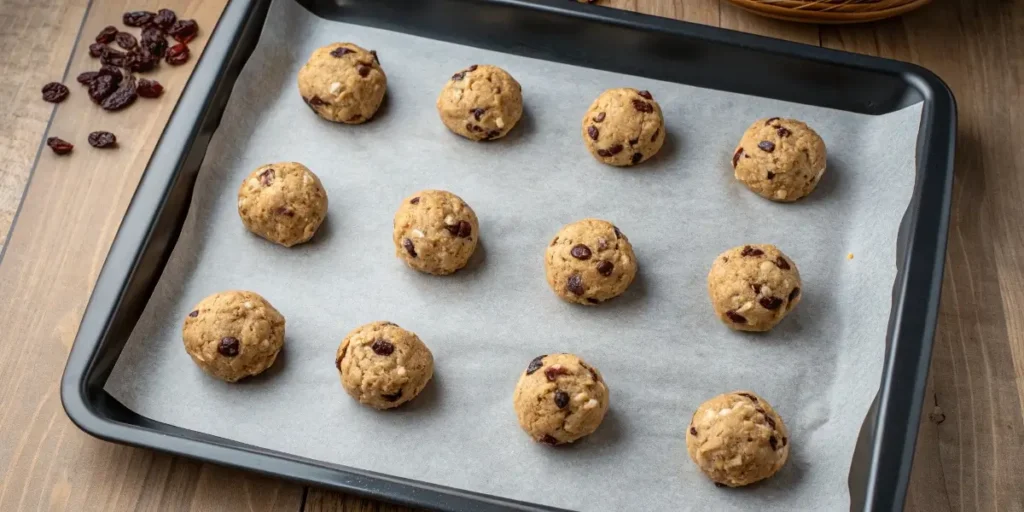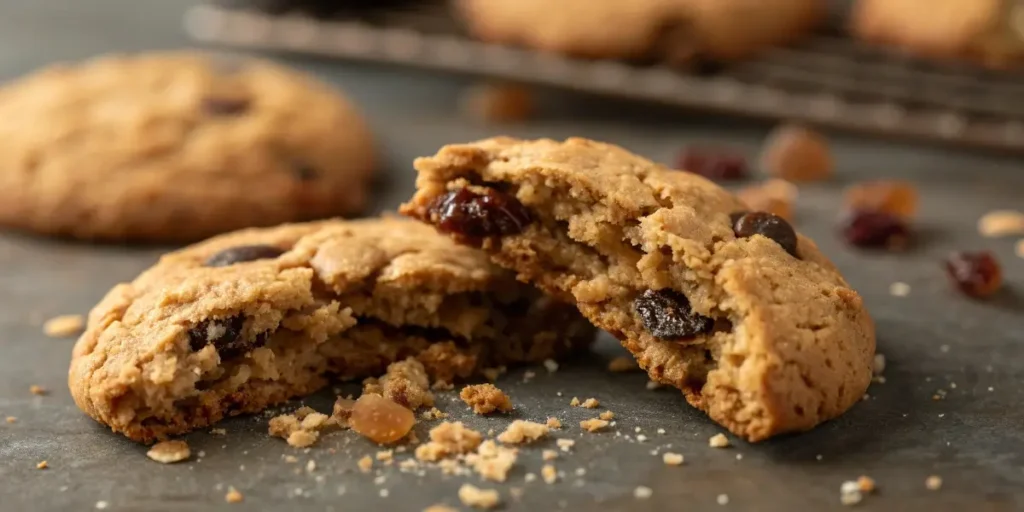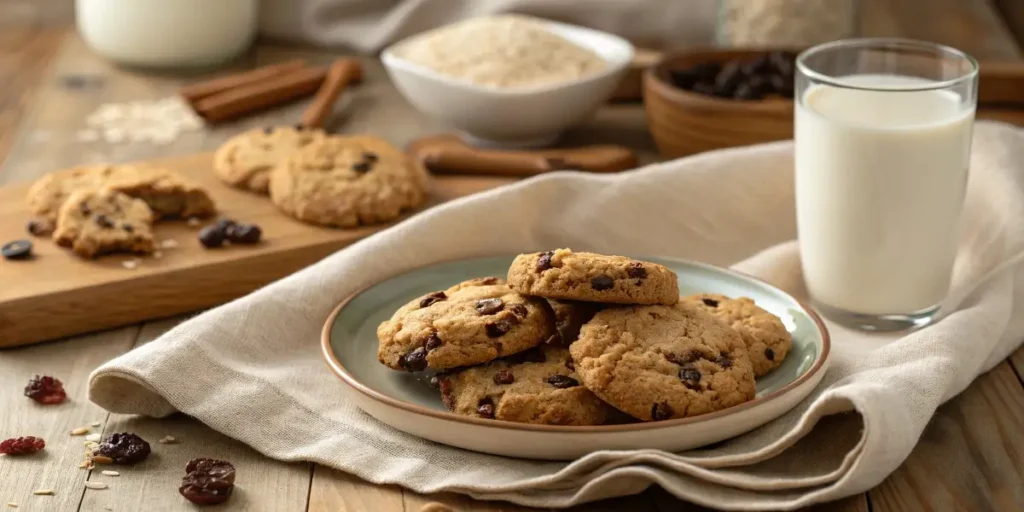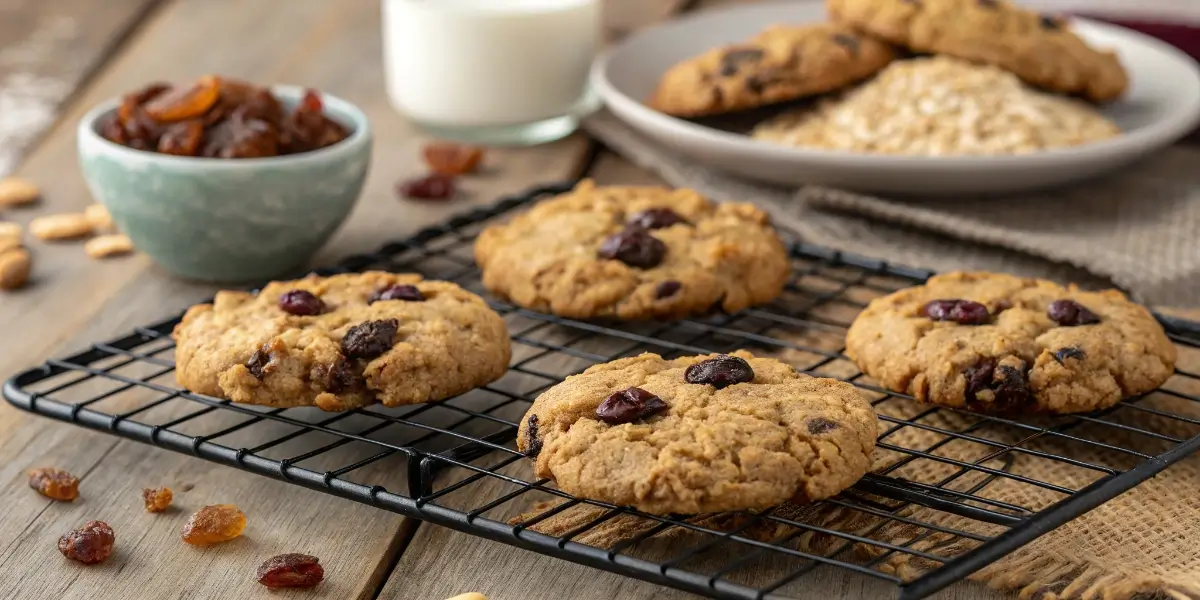Oatmeal Raisin Cookie Recipe – The Best Classic Cookie You’ll Ever Bake
There’s something undeniably comforting about the aroma of freshly baked oatmeal raisin cookies filling your kitchen. This classic oatmeal raisin cookie recipe combines chewy oats, sweet raisins, and a hint of cinnamon to create a cookie that feels both nostalgic and wholesome. Whether you’re baking for a cozy afternoon treat or a holiday dessert platter, this recipe delivers timeless flavor and perfect texture every single time. Learn more about traditional cookie baking techniques in our delicious Toll House cookies guide for inspiration.
Table of Contents
The Story Behind the Oatmeal Raisin Cookie Recipe
The Origin of Oatmeal Raisin Cookies
The beloved oatmeal raisin cookie recipe has roots that go back centuries. Originally inspired by Scottish oatcakes, this treat made its way to American kitchens in the late 1800s when oats became a common pantry ingredient. Bakers began adding sugar, butter, and dried fruit, creating the foundation of the cookie we know today. By the early 1900s, recipes started appearing on oatmeal containers, cementing the cookie’s popularity. The combination of hearty oats and natural sweetness from raisins offered both flavor and sustenance, turning it into a staple dessert across generations.
If you enjoy traditional bakes, don’t miss our Amish cinnamon bread recipe — another old-fashioned favorite that pairs perfectly with a glass of milk.
Why This Oatmeal Raisin Cookie Recipe Is Timeless
What makes the oatmeal raisin cookie endure decade after decade? It’s that perfect blend of texture and warmth — slightly crisp edges with a soft, chewy center. The oats give the cookies a hearty bite, while the raisins add bursts of sweetness that balance beautifully with brown sugar and vanilla. A touch of cinnamon enhances the aroma, creating that home-baked comfort we all crave. This recipe’s timeless appeal lies in its simplicity: it’s easy to make, endlessly adaptable, and guaranteed to please both kids and adults alike.
For more oat-inspired ideas, check out our lemon oatmeal no-bake cookies, a refreshing twist on the traditional cookie theme.
Ingredients for the Perfect Oatmeal Raisin Cookie Recipe
Essential Ingredients and Why They Matter
Every great oatmeal raisin cookie recipe starts with simple pantry staples—but each one plays a vital role in achieving that perfect chewy bite. Let’s break them down:
| Ingredient | Function in Recipe | Substitution Options |
|---|---|---|
| Old-fashioned rolled oats | Adds chewiness and structure | Quick oats for a softer cookie |
| All-purpose flour | Binds ingredients and gives texture | Whole wheat flour for added fiber |
| Brown sugar | Keeps cookies moist and adds caramel flavor | Coconut sugar for a natural sweetness |
| Granulated sugar | Balances flavor and crispness | Use only brown sugar for softer cookies |
| Butter | Adds richness and a soft crumb | Coconut oil for dairy-free version |
| Eggs | Bind dough and add moisture | Flax egg for vegan option |
| Raisins | Add chewy sweetness | Dried cranberries or chopped dates |
| Cinnamon & vanilla | Deepen flavor and aroma | Try nutmeg or allspice for a twist |
| Baking soda & salt | Create lift and balance sweetness | Baking powder (in a pinch) |
These carefully balanced ingredients make sure your cookies come out tender, flavorful, and golden brown every time. The right oatmeal raisin cookie recipe isn’t about complexity—it’s about perfect proportions and smart substitutions.
If you love experimenting with pantry staples, check out our cottage cheese banana bread for another wholesome baking idea.
Substitute Ideas for Healthier Oatmeal Raisin Cookies
Health-conscious bakers can easily adapt this recipe without sacrificing flavor. Swap half the butter for unsweetened applesauce to reduce fat while maintaining moisture. Replace white flour with oat flour for added fiber and texture, or choose organic coconut sugar for a lower-glycemic sweetness. You can even toss in a handful of chia or flax seeds for extra nutrients.
For a gluten-free twist, use certified gluten-free oats and a 1:1 gluten-free flour blend—your cookies will still bake up chewy and satisfying.
Looking for inspiration? Try our healthy shredded chicken recipes for balanced meal ideas to pair with your dessert.
Step-by-Step Oatmeal Raisin Cookie Recipe Instructions

Preparation and Mixing Techniques for Best Texture
To make the best oatmeal raisin cookie recipe, proper mixing is everything. Start by creaming together butter, brown sugar, and granulated sugar until light and fluffy. This step helps trap air, giving your cookies that ideal balance of crisp edges and chewy centers. Beat in the eggs one at a time, followed by vanilla extract, which enhances the overall flavor.
In a separate bowl, whisk together flour, baking soda, salt, and cinnamon. Gradually add the dry mixture into the wet ingredients until just combined—overmixing here can toughen your cookies. Stir in rolled oats and raisins by hand, ensuring an even distribution without deflating the dough.
Pro tip: For extra plump raisins, soak them in warm water (or a splash of rum) for 10 minutes before folding them in. Pat them dry before adding to avoid excess moisture.
If you’re into easy home baking, learn more about soft dough consistency in our irresistible oatmeal cream pies guide.
Baking Time, Temperature, and Expert Tips
Preheat your oven to 350°F (175°C) and line baking sheets with parchment paper. Scoop tablespoon-sized portions of dough, spacing them about 2 inches apart to allow for spreading. Bake for 10–12 minutes, or until the edges are golden but the centers look slightly underdone—this ensures that chewy texture once cooled.
Let the cookies rest on the baking sheet for 5 minutes before transferring to a wire rack. This resting phase allows the centers to finish baking from residual heat. Store cookies in an airtight container with a slice of bread to keep them soft for days.
Expert tip: If you prefer crispy cookies, simply flatten your dough balls slightly and extend the baking time by 1–2 minutes.
Don’t miss our pecan cookies recipe for another nutty, chewy delight that complements this oatmeal classic beautifully.
Choosing the Best Oats for Oatmeal Raisin Cookies
Rolled Oats vs. Quick Oats: What’s Better?
The choice of oats makes a significant difference in your oatmeal raisin cookie recipe. Old-fashioned rolled oats are the go-to option for most bakers because they maintain their structure during baking, giving cookies that ideal chewy texture and hearty bite. Rolled oats absorb moisture more slowly, preventing the dough from becoming too wet or sticky.
Quick oats, on the other hand, are pre-cut and steamed longer, so they create a smoother texture and softer cookie. If you prefer a more uniform appearance or a less chewy consistency, quick oats work well. However, they can make your cookies more cake-like rather than chewy.
For a texture that’s perfectly balanced—crispy edges with a soft center—use rolled oats. Some bakers even mix half rolled and half quick oats for the best of both worlds. Learn more about oat-based baking variations in our lemon oatmeal no-bake cookies recipe.
Can You Use Quaker Oats for Oatmeal Raisin Cookies?
Absolutely! Quaker oats are among the best choices for this classic recipe. Their rolled oats maintain consistency and quality, ensuring your cookies bake evenly with a reliable chewy texture. Both Quaker’s old-fashioned rolled oats and quick oats can be used, but the rolled version delivers a superior texture that aligns with traditional oatmeal cookies.
If you have gluten sensitivities, look for Quaker Gluten-Free Rolled Oats, which guarantee the same rich flavor without cross-contamination. You’ll get that wholesome nutty taste and chewy consistency that defines the best oatmeal raisin cookie recipe.
For another sweet idea using oats, check out our peanut butter overnight oats for a protein-packed breakfast that feels like dessert.
How to Make Oatmeal Raisin Cookies Extra Chewy

The Role of Butter, Sugar, and Eggs in Cookie Chewiness
If your goal is that perfect, bakery-style chew, the secret lies in how you balance butter, sugar, and eggs in your oatmeal raisin cookie recipe. Softened unsalted butter creates a tender texture, while brown sugar adds moisture and a subtle molasses flavor that keeps cookies chewy even days later. Using more brown sugar than white sugar is a pro tip that ensures a soft bite every time.
The egg yolk is another key player—it provides fat and richness, which help maintain chewiness. If you want your cookies extra moist, add one extra egg yolk without increasing the egg whites. This gives you a denser, more indulgent texture.
Learn more about achieving perfect consistency in doughs and batters in our sourdough breakfast recipes, where texture balance is just as crucial.
Should You Soak Raisins Before Baking Oatmeal Cookies?
Yes—soaking raisins before adding them to your dough makes a big difference. Dry raisins can absorb moisture from your cookies, making them dense or dry. To prevent that, soak your raisins in warm water for 10 to 15 minutes before baking. Drain and pat them dry before folding them into the dough.
If you want to take the flavor up a notch, try soaking raisins in dark rum, brandy, or orange juice for an aromatic twist. This simple step plumps up the raisins, giving every bite a juicy burst of sweetness that elevates your oatmeal raisin cookie recipe from classic to gourmet.
Don’t miss our date nut bread recipe for another dessert where soaked dried fruit creates unbeatable flavor and texture.
Common Oatmeal Raisin Cookie Mistakes to Avoid
Overbaking and Wrong Oatmeal Choices
Even the best oatmeal raisin cookie recipe can fall short if you make small but crucial mistakes during baking. One of the most common errors is overbaking. These cookies should come out of the oven when the edges are golden and the centers still look slightly underdone. They continue baking on the hot pan, so taking them out too late can make them dry and hard instead of chewy.
Another mistake is using the wrong type of oats. Instant oats or steel-cut oats can completely change the texture. Instant oats dissolve into mush, while steel-cut oats stay too tough to chew. Always stick to old-fashioned rolled oats for the ideal texture and flavor balance.
If you’d like to see how baking time affects texture, check out our red velvet waffles recipe — a great example of timing precision in baking.
Mixing Mistakes That Ruin Texture and Flavor
When it comes to cookie dough, overmixing is your enemy. Once you add the dry ingredients, mix only until the flour is incorporated. Overworking the dough develops too much gluten, making cookies tough instead of tender.
Temperature also matters. Using butter that’s too melted can cause cookies to spread too much, leading to thin, greasy results. Aim for softened butter—pliable but still slightly cool to the touch.
Lastly, don’t skip the chilling step if the recipe calls for it. Chilling allows the flour to hydrate and the fats to solidify, ensuring cookies bake evenly and hold their shape.
Discover great baking precision in our biscuit egg cheese casserole recipe — where balancing texture is just as vital for a perfect result.
How Healthy Are Oatmeal Raisin Cookies?
Nutritional Benefits of Oats and Raisins
At first glance, an oatmeal raisin cookie recipe might seem indulgent—but these cookies actually pack a few hidden health perks. Oats are loaded with soluble fiber, particularly beta-glucan, which supports heart health and helps regulate blood sugar levels. They also provide complex carbohydrates that release energy slowly, making you feel satisfied longer.
Raisins, meanwhile, are naturally sweet and rich in iron, potassium, and antioxidants. They offer natural sugar instead of refined sweeteners, which helps reduce the overall glycemic impact when balanced properly. Together, oats and raisins make for a snack that’s both comforting and nourishing.
When you bake these cookies with whole grain oats, reduced sugar, and heart-healthy fats like coconut oil or avocado oil, they become a better alternative to traditional sugar-laden desserts. If you’re interested in more wholesome treats, check out our gluten-free carrot cake — a sweet that’s both nutritious and satisfying.
How to Make a Healthier Version of This Recipe
With a few smart swaps, your oatmeal raisin cookie recipe can fit neatly into a balanced diet. Replace half the butter with unsweetened applesauce to lower fat while keeping the cookies moist. Use coconut sugar or honey instead of refined white sugar for a more natural sweetness. You can also reduce the sugar by 25%—the raisins’ natural sugars will still make the cookies taste great.
Try adding chia seeds, flaxseed meal, or a scoop of protein powder to boost nutritional value. For a vegan version, use a flax egg (1 tablespoon flaxseed meal + 3 tablespoons water) and coconut oil in place of butter.
Want more healthy inspiration? Don’t miss our chia seed coconut milk pudding, another nutrient-packed dessert that proves healthy can still mean delicious.
Storage and Serving Ideas for Oatmeal Raisin Cookies

How to Keep Oatmeal Raisin Cookies Soft and Fresh
A great oatmeal raisin cookie recipe deserves proper storage so your cookies stay as chewy and flavorful as when they first came out of the oven. The key is controlling moisture. Once cooled completely, store cookies in an airtight container at room temperature. To retain that soft, bakery-style texture, add a slice of sandwich bread or a marshmallow to the container — they’ll release moisture slowly, keeping your cookies soft for up to five days.
If you prefer to make cookies ahead of time, you can freeze the dough balls on a baking sheet and transfer them to a resealable freezer bag. Bake them directly from frozen by adding 2–3 extra minutes to the baking time. This trick ensures you always have fresh oatmeal raisin cookies whenever cravings strike.
Creative Serving and Pairing Suggestions
Serving your oatmeal raisin cookies can be as creative as baking them. For a comforting treat, serve warm cookies with a cold glass of milk or a steaming mug of chai latte. For dessert platters, drizzle melted white or dark chocolate over cooled cookies for a bakery-style presentation.
You can also crumble these cookies over vanilla ice cream, Greek yogurt, or banana pudding for a delicious textural contrast. Want something indulgent? Sandwich a scoop of ice cream between two cookies for a nostalgic frozen dessert.
Don’t miss our peach blueberry cobbler for another cozy dessert that pairs perfectly with coffee or tea after a hearty meal.
Conclusion: Why This Oatmeal Raisin Cookie Recipe Deserves a Spot in Your Kitchen
There’s a reason this oatmeal raisin cookie recipe has been loved for generations. It’s simple, flexible, and full of wholesome ingredients that make it feel homemade in every bite. Whether you enjoy them warm with a glass of milk or packed as a sweet lunchbox treat, these cookies deliver both comfort and satisfaction. And with a few tweaks, you can make them as indulgent or as healthy as you like.
Don’t miss our delicious brioche French toast casserole for another cozy baked treat that pairs perfectly with a batch of these cookies.
FAQs
Should you soak raisins before baking cookies?
Yes, soaking raisins is a small step that makes a big difference. In any oatmeal raisin cookie recipe, soaked raisins stay plump and juicy during baking. Simply cover them in warm water or orange juice for about 10–15 minutes, then pat them dry. This prevents the raisins from drawing moisture out of the dough, keeping your cookies soft and chewy instead of dry.
How healthy are oatmeal raisin cookies?
Oatmeal raisin cookies can be a healthier dessert option compared to traditional chocolate chip cookies. Oats provide fiber and protein, while raisins offer antioxidants and natural sweetness. You can make them even healthier by reducing sugar, using whole-grain oats, or swapping part of the butter for applesauce.
What are the most common mistakes when making oatmeal cookies?
Common missteps include overmixing the dough, using the wrong oats, or overbaking. Overmixing develops too much gluten, leading to tough cookies. Using instant oats can make the dough too soft, while overbaking dries them out. Always remove the cookies when the centers are slightly soft—they’ll firm up as they cool.
What kind of oatmeal is best for oatmeal raisin cookies?
The best choice is old-fashioned rolled oats. They give cookies that signature chewy texture without becoming mushy. Avoid steel-cut oats (too hard) and instant oats (too soft). Rolled oats provide the perfect bite and absorb moisture evenly.
Can I use Quaker oats instead of rolled oats?
Absolutely. Quaker old-fashioned oats are rolled oats and perform beautifully in most recipes. They offer a hearty texture, bake evenly, and create that comforting, chewy consistency everyone loves. If you only have Quaker quick oats, they’ll work too—your cookies will just be a bit softer.
What are common cookie mistakes?
Beyond overbaking and overmixing, other frequent mistakes include not chilling the dough, measuring flour incorrectly, or using melted butter instead of softened butter. Always spoon and level your flour instead of packing it into the cup, and chill your dough at least 30 minutes before baking for better shape and flavor.

